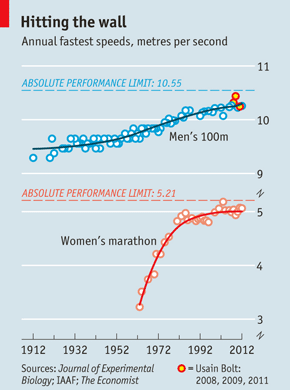Is it time to update the Olympic credo?
The Economist explores the question of whether the human body has maxed-out when it comes to breaking future Olympic athletic records.
The Aug. 4 article “Faster, higher, no longer” quotes SMU’s Peter Weyand, an expert in human speed and human locomotion.
Weyand helped lead a team of scientists who are experts in biomechanics and physiology in conducting experiments on South African Olympic sprinter Oscar Pistorius, a double amputee whose artificial “Cheetah” legs have stirred controversy, and the mechanics of his racing ability.
Weyand is widely quoted in the press for his expertise on human speed. He is an SMU associate professor of applied physiology and biomechanics in the Annette Caldwell Simmons School of Education & Human Development.
EXCERPT:
The Economist
ON AUGUST 5th millions of people will watch the 100-metre final at the London Olympics. Many will wonder if anyone can repeat Usain Bolt’s feat in Berlin in 2009, when the Jamaican clocked 9.58 seconds, lopping 0.11 seconds—aeons in a sprint—off the previous world record, which he set at the 2008 Beijing games.One person who thinks this unlikely is Mark Denny. Another 0.11 seconds would take the time below what Dr Denny, from Stanford University, reckons is the absolute limit of human athletic performance in the 100-metre dash.
In 2008 Dr Denny published a paper in which he crunched through the highest speeds achieved each year in running events from sprints to the marathon, some dating back to 1900 (see chart). A statistical technique called extreme-value analysis discerned trends and the maximum possible deviations from them. For the 100 metres, the human speed limit is 10.55 metres per second. This translates to 9.48 seconds.
Predicting the limits of human athletic prowess has been a popular parlour game among number crunchers. One study from 1992 had female marathon runners drawing level with men by 1998, to complete the 42.195km (26.2-mile) course in just under two hours and two minutes. (The current male record remains 1.5 minutes slower; for women it is 12 minutes slower still.) A more recent analysis from 2004 suggested that male and female 100-metre times will converge in 2156, at 8.08 seconds.
Nowadays sport statisticians view such calculations as flawed because they relied on linear extrapolations. They prefer to fit data to variants of a “logistic” curve. This produces an S-shaped plot more in line with the intuition that performance starts off relatively flat. It then goes through a period of rapid improvement as more people take part and more systematic approaches to training and nutrition get more out of them. It finally levels off as athletes inch towards the most a body can manage. [ … ]
[ … ] Statistics suggest that feats like those of Messrs Bolt and Beamon are increasingly improbable. But are they impossible? Peter Weyand, of Southern Methodist University in Texas, has shown that whereas the peak force which elite sprinters apply to the track is more than four times their body weight, they can squeeze even more out of their muscles. Dr Weyand found that the forces generated while athletes hopped on one leg as fast as they could on a high-speed treadmill were roughly twice as high as during running at top speed. This translated into 30% more ground force.
Since ground force is the main determinant of sprinting speed, Dr Weyand’s results imply that human muscles are capable of producing enough oomph to propel sprinters one-third faster than Mr Bolt’s 2009 record. The reason they have not is that in the normal, two-legged gait the foot is in contact with the ground for only around one-tenth of a second, 0.05 seconds less than when hopping. As a consequence, muscle fibres do not have enough time to contract to their full potential. Although tapping all this force while sprinting seems biomechanically inconceivable, there may be scope for slight alterations in training and gait, focused on increasing the peak power available to sprinters. For his part, Dr Denny would be thrilled to see any athlete breach his limits, but he isn’t putting any money on it.
SMU is a nationally ranked private university in Dallas founded 100 years ago. Today, SMU enrolls nearly 11,000 students who benefit from the academic opportunities and international reach of seven degree-granting schools. For more information see www.smu.edu.
SMU has an uplink facility located on campus for live TV, radio, or online interviews. To speak with an SMU expert or book an SMU guest in the studio, call SMU News & Communications at 214-768-7650.



 Human diabetes has new research tool: Overfed fruit flies that develop insulin resistance
Human diabetes has new research tool: Overfed fruit flies that develop insulin resistance Observed! SMU’s LHC physicists confirm Higgs ‘God particle’
Observed! SMU’s LHC physicists confirm Higgs ‘God particle’ DOE Award: advancing SMU’s link to the God particle
DOE Award: advancing SMU’s link to the God particle Ancient tree-ring records from southwest U.S. suggest today’s megafires are truly unusual
Ancient tree-ring records from southwest U.S. suggest today’s megafires are truly unusual Modeling the human protein in search of cancer treatment: SMU Researcher Q&A
Modeling the human protein in search of cancer treatment: SMU Researcher Q&A